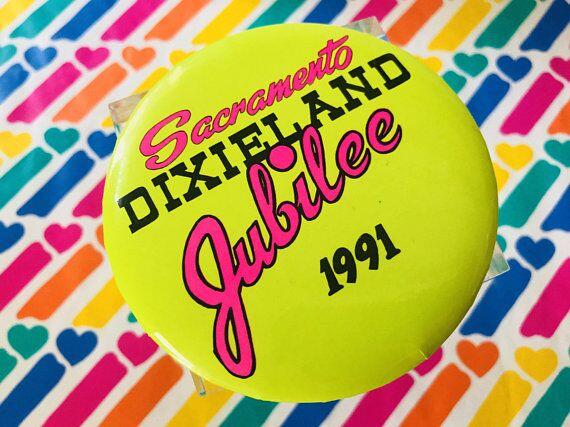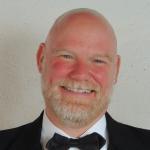 At first perusal, this edition might not seem too inspirational. It certainly isn’t funny; it may appear somewhat gloomy, if not “doomy.” But bear me out and decide if you can see some light and hope at the end of this column.
At first perusal, this edition might not seem too inspirational. It certainly isn’t funny; it may appear somewhat gloomy, if not “doomy.” But bear me out and decide if you can see some light and hope at the end of this column.
The height of the US Dixieland Festival parade (yes, I’m using that D-word as many of the events never hesitated including it) is generally thought to be the mid-1970s through the late-1980s; during this halcyon era you had your pick of a festival featuring Classic Jazz and/or Ragtime EVERY weekend of the year—you’d sometimes have to choose from two or three happening concurrently throughout the country. It was a boom for bands, audiences, and host towns or cities sharing a three-to-four-day event celebrating hot music from the first half of the 20th century.
Here is a partial list of US festivals/parties (with a couple of Canadian events thrown in) that have ceased to exist, listed from memory—feel free to check the ones you attended (or planned to attend but never were able to) or played:
Sleeping Giant Swing-N-Jazz Jubilee (Helena, MT)
Mammoth Jazz Jubilee (Mammoth Lakes, CA)
Medford Jazz Festival (Medford, OR)
Orange County Classic Jazz Festival (Costa Mesa, CA)
The Great CT Traditional Jazz Festival (Essex, then Moodus, then Guilford, then Wallingford, CT)
The Hot Steamed Jazz Festival (Essex, CT)
Sisters Jazz Festival (Sisters, OR)
TerriVIC Jazz Party (Victoria, BC, Canada)
Sidney Jazz Festival (Sidney, BC, Canada)
Tom Turpin Ragtime Festival (Savannah, GA)
Glacier Jazz Stampede (Kalispell, MT)
Lake of the Ozarks Jazz Festival (Osage Beach, MO)
Summit Jazz (Denver, then Aurora, CO)
Big Bear Lake Jazz Festival (Big Bear Lake, CA)
Sacramento Music Festival—originally Old Sacramento Dixieland Jazz Jubilee (Sacramento, CA)
Friday Harbor Jazz Festival (Friday Harbor, WA)
America’s Classic Jazz Festival (Olympia, then Lacey, WA)
Seaside Jazz Festival (Seaside, OR)
Gateway Jazz Festival (St. Louis, MO)
Central Illinois Jazz Festival (Decatur, IL)
Evergreen Ragtime Bash (Evergreen, CO)
Eau Claire Ragtime Festival (Eau Claire, WI)
Capital City Jazz Fest (Madison, WI)
EarlyJas Festival (Strongsville, OH)
Jeff&Joel’s House Party (Guilford, then Branford CT)
Zehnder’s Jazz Festival (Frankenmuth, MI)
Bessie Smith Traditional Jazz Festival (Chattanooga, TN)
Shasta Dixieland Jazz Festival (Redding, CA)
Sweet and Hot Jazz Festival (Los Angeles, CA)
Indianapolis Classic Ragtime Society Festival (Indianapolis, IN)
Arbors Records March of Jazz (Clearwater, FL)
This is a substantial list, and these events are merely the ones in which I remember performing one or more times; there may be others I’ve forgotten and there were certainly more than are listed here that I never had the honor of playing. Most were three-day events with a handful extending to four or even six days. Some of the larger ones would boast 15,000-20,000 or more attendees; the Original Sacramento festival drew 100,000+ in its heyday.
Theories abound as to why the Classic Jazz festival/party scene is shrinking so I won’t belabor that issue here. (For that discussion read Lew Shaw’s: “A Crisis of the Old Order” and Joe Bebco’s response “What Is to Be Done?” ) By now, most of you who have read previous installments of this column are wondering when I’ll get to the “inspirational” part. The positive takeaway here is that there STILL exist a few dozen medium to large events dedicated to providing listeners and dancers with a weekend of hot jazz and ragtime throughout the year in the US. We can all take small steps, at very minimal expense, to help prolong the life of this phenomenon.
[N.B. My good friend, avid blogger, audience member, and fellow TST columnist Michael Steinman, composed a prescient piece for his blog Jazz Lives called “‘Asses in Seats’ and the Jazz Ecosytem” (Jan. 2020) with a similar message to mine so I have taken care to offer additional ways to support the classic jazz/ragtime scene rather than repeat his suggestions. I urge you to read this blog, as well as all of Michael’s offerings]

I’ll begin by acknowledging that we are still in uncertain times and any of the following should be attempted only as much as your individual sense of risk allows; the good thing is that these ideas will still bear your consideration long after we’ve pushed our way through this centenary pandemic. That caveat out of the way, now you are doubtlessly musing, “How can I help the classic jazz scene going?” Here’s how:
1) Almost no matter where you live in the mainland US, chances are there is an annual event offering up early jazz and/or ragtime somewhere within several hours’ drive away from you. You don’t have to take in (or incur the expense of) all three days of the event! You need only spend one night away from home to enjoy 8-12 hours of jazz or more; you can leave your home after breakfast and return the next day before cocktail time.
2) If you’ve a large enough vehicle, invite close friends who may not have yet experienced the party atmosphere of a jazz festival. Buy them their badges or bribe them with dinner in-between sessions. You may create a couple more converts!
 3) If you are already a regular attendee of a festival event, consider becoming a sponsor or patron. Nearly every festival offers levels of sponsorship beginning at modest levels. Often, your extra shekels will earn you perks such as priority seating, a bit of jazz “swag” or a patron’s only party with cocktails or canapés. You’ll also bask in the knowledge that a little goes a long way, and you are doing your part, beyond attending, to help ensure the survival of your chosen event.
3) If you are already a regular attendee of a festival event, consider becoming a sponsor or patron. Nearly every festival offers levels of sponsorship beginning at modest levels. Often, your extra shekels will earn you perks such as priority seating, a bit of jazz “swag” or a patron’s only party with cocktails or canapés. You’ll also bask in the knowledge that a little goes a long way, and you are doing your part, beyond attending, to help ensure the survival of your chosen event.
4) Give a physical or online gift subscription to this publication to friends who enjoy good writing and humor, no matter what the topic. They’ll notice the panoply of passion and possibilities surrounding our jazz/ragtime community and will perhaps independently search out the most convenient way to join in the fun.
5) Many festivals that were postponed or presented only in virtual format will continue that virtual element going forward as they reconvene in real-time. If you are not healthy or wealthy enough to physically attend, you can become a member of the fast-growing virtual audience base and “attend” events thousands of miles away from where you are located. You’ll also then be able to take advantage of the possibility to contribute any monetary amount to the event to assist in its longevity.
6) If you ARE healthy (though not necessarily wealthy) enough and have a group of like-minded supporters around you, start your OWN event!! Perhaps as small an event as a house concert presenting one of your favorite acts. If you’d like to expand beyond that, begin small with two or three local bands playing during a single day and if crowds and success demand, grow gradually to include bands from farther away and increase the length of your event. See if you can get town support for your idea (more likely if your locale has a “shoulder season”) and impress upon them that increased traffic in town will benefit merchants and restaurateurs.
You’ll no doubt come up with additional ideas as to how to get involved. The easiest way is simply to show up and put your ass in a seat (Thank you, Mssr. Steinman) whether it be at the event or in front of your computer.
If festivals are too hectic for you, explore different ways to get your music fix. Small clubs and restaurants offer live jazz throughout the country. There are also one-time concerts/dances scheduled in Grange Halls, VFW’s, Elks, Lions, Eagles (or myriad other animals) Lodges several times a year in many towns and cities.
For something completely different, my wife Anne and I have been engaged to offer several five-day lecture/concert programs on historic Jekyll Island, GA for the national Road Scholar organization beginning October 2021, throughout 2022, and into 2023. Some sessions have already sold-out—attendance is limited to 40 people per session to enhance the experience. On an even more intimate scale, many of your favorite musicians, including myself, are giving lessons in person, if safe and possible, or online. Dust off that old horn or those keys and make some music yourself!! Whether you play, listen or both, JOIN IN so our musical heritage—not to mention all the FUN—doesn’t wither!
Jeff Barnhart is an internationally renowned pianist, vocalist, arranger, bandleader, recording artist, ASCAP composer, educator and entertainer. Visit him online atwww.jeffbarnhart.com. Email: Mysticrag@aol.com























